
We’ve seen a number of dramatic changes in the marketing landscape since COVID-19 hit the world. One of the most prominent and lasting adjustments for all of us are virtual experiences. Brands and consumers have had to adjust to doing just about everything remotely using any virtual means necessary.
Because of our sheer reliance on digital both during this crisis and as we move forward, brands will absolutely need to have a virtual strategy in place to ensure their future success.
This guide offers actionable ways to create a strategy, adopt tools and platforms, and hopefully even walk away with some positive energy around how you can continue selling and gaining market share through virtual experiences.
The Necessity of Virtual Solutions
In the last few months, we’ve seen the 2020 Summer Olympics, SXSW, Cannes Film Festival and a whole host of other well-known events get cancelled or rescheduled. There probably isn’t a niche industry out there that hasn’t seen their own trade shows or customer-facing events get completely scrapped or put in a state of perpetual limbo. Early estimates from The Global Association of the Exhibition Industry indicate that more than 500 trade shows have not taken place, resulting in over 26 billion dollars in lost revenue for exhibitors.
Beyond trade shows, internal team get-togethers and smaller sales meetings with customers and prospects have taken a hit. The ability to physically present and share new products and services has disappeared. These are imperative daily activities when executing a proper sales enablement strategy.
Before COVID-19 wreaked havoc on upcoming marketing calendars, roughly 25% of brands’ marketing budgets — on average — were dedicated to in-person events. These range from trade shows to sales conferences to team trainings and more.
Brands cannot just push the pause button and wait it out. They still need to do all the things they were doing before to remain a healthy revenue-generating business. This includes driving demand, generating and then nurturing leads, enabling sales teams, updating retail partners, and a whole host of other important marketing and sales initiatives.
Around the country, things are beginning to open up at the local level, but we are still a long way from safely being able to get on a plane and get in a room with a large number of colleagues and customers. Midmarket up to enterprise-level brands with global, national and regional footprints need to stay connected with customers, partners and team members, otherwise their relevance will quickly begin to erode.
This has left companies racing to accelerate their digital transformation plans, with 70% of companies admitting to having a plan in place to do so. Then in the virtual event space, 78% of marketing leaders say they expect to increase or significantly increase their virtual marketing and events budgets.
Each brand has its own unique set of internal vs. external needs, customers, tech stack and a host of other factors that they need to account for or will play a role in how they develop virtual experiences. There are lots of different directions to go in when creating a virtual event. Let’s explore some of the most common:
We should also make an important distinction between solely virtual vs. hybrid experiences. A virtual event is run entirely online with no live in-person interaction, while the hybrid approach is an experience that combines a live in-person event in conjunction with a virtual online component.
As things begin to open up, hybrid solutions will become more popular as industry professionals, thought leaders and brand teams come together. The hybrid approach delivers engaging in-person interaction that can only be achieved face-to-face, while offering the flexibility, scale and tracking benefits can come with digital. While many of the topics covered in this piece of content can be achieved through a virtual or hybrid approach, we are focused on explaining the virtual online aspects.

The shift to virtual is affecting what the typical buying journey looks like, especially in the B2B space. Changes in the business buyer’s journey are going to be more pronounced due to the fact that they are more relationship-driven, span across longer sales cycles and involve many more decision makers vs. consumer ones. Let’s take a closer look at the typical B2B customer buying stages and the steps taken to make a decision.
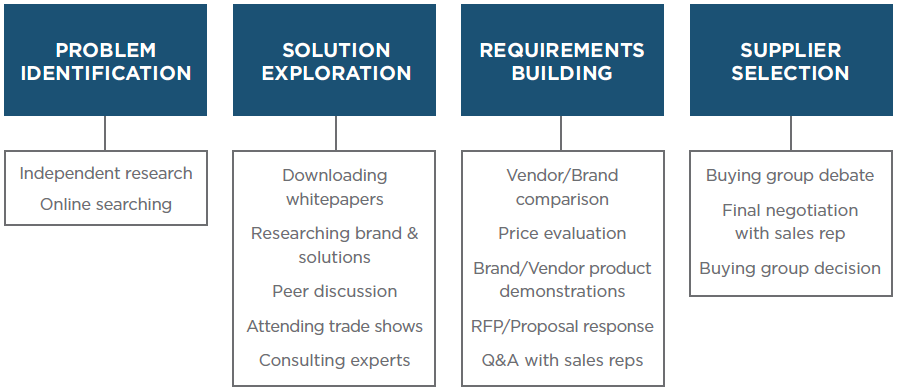
Since many of us have been working remotely and cannot attend meetings and shows for the foreseeable future, we’ve highlighted the in-person aspects of the purchase journey that now require a virtual solution. As you can see, the new journey spans across both internal and external aspects of how we typically come to a decision.
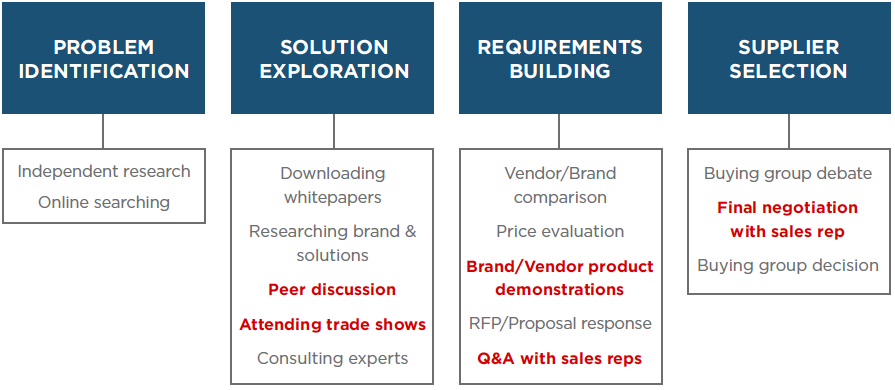
The net takeaway is that brands must adjust to a digital-first approach to meet customer needs in the areas of trade shows, product demonstrations and live sales meetings that span across multiple stages of the journey. Now let’s take a look at what the new buying journey looks like with a 100% virtual approach.
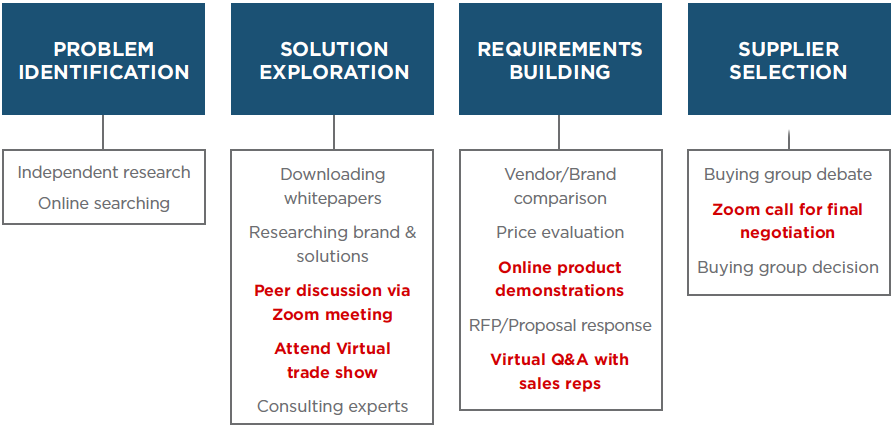
As you can see, more of the onus now falls on virtual marketing solutions to fill in the gaps. To replicate the personal touch in-person events offered, each virtual experience needs to deliver high levels of personalization, dynamic product demonstrations, and marketing and sales actions.

The Necessity of Virtual Solutions
Shaping Your Virtual Approach
You might already have some virtual or hybrid events in the works or you’re just starting out, but we can probably all agree now’s the time to jump head first in the virtual game. The one update that may bring you some solace is that there’s an entire sector in the Martech space hard at work creating technology, platforms and all forms of virtual solutions to help guide you down this path. By leveraging these tools, brands can still conduct their event marketing, lead generation and nurturing efforts to continue selling and gaining market share.
To help define and shape your virtual event, start by answering the following list of questions and take note of the applications to help guide you through the process.
| Question | Application |
| What exactly are you trying to replicate with your virtual event? | Helps guide the type of virtual event, hosting platform functionality and whom you’ll need to invite. Typical events can range from trade show experiences to sales team training to customer product demos to thought-leadership webinars. |
| How will you define success in terms of KPIs? | Defines the type of virtual event, overall objective and whom you’ll need to invite. Also necessary for establishing event action and conversion tracking. |
| What is your agenda? | Allows you to begin creating a run of show, content strategy and begin thinking about platform functionality (i.e. welcome content, keynote speaker, Q&As, breakout rooms, live polling, etc). Also help establish which teams and individuals in your organization will need to be involved. |
| What content do you plan on sharing? | Guides you specifically in the area of content creation including product demos, video assets, infographics, image galleries, downloadable PDFs and whitepapers, FAQ, etc. |
| Who are your ideal attendees (i.e. visitors of last year’s trade show booth, sales team prospects, new target personas, internal sales teams, etc.)? | Helps guide your event content strategy and hosting platform needs in terms of functionality and attendee capacity. |
| How many people does your virtual event need to accommodate for? | This aids in selecting an appropriate hosting platform and helping with an outreach strategy. |
| How do you plan on driving attendees to your event? | Steers your outreach and prospecting approach, which can include email drip campaigns, the use of incentives, account-based marketing, managing the registration process and more. |
| How are you going to drive strong engagement? | Gets you thinking on creating immersive multi-touch experiences with features like videos, 3D animation, live polling, influencers, content downloads, giveaways, breakout sessions, custom hashtags, etc. |
| What are your virtual hosting platform functionality needs? | Guides specific functionality features to account for (i.e. keynote speaker, product demos, breakout rooms, polling, live Q&A, chat bots, content downloads, etc.). |
| What types of actions are you seeking from attendees (e.g. form fills, video views, content PDF downloads, etc.)? | Defines which CTAs need to be built into the experience such as form fills, PDF downloads, request for follow up information, lead generation forms, etc.). |
| Do you plan on selling products or services at the event? | This will determine if sales teams need to be brought into the experience and if functionality in the platform is required (i.e. breakout or chat room with a sales rep, purchase CTAs, etc.). |
| How can I keep the conversation going after the event? | Strategize on how you can use metrics and learnings from your event to reconnect with attendees post-event with things like tracking engagement, using cookies, and putting your CRM to work with follow-up content and promotional offers. |

The Necessity of Virtual Solutions
Now that we’ve framed our approach, let’s explore how specific types of virtual experiences can achieve real-world business solutions.
If you’re in the business of demand generation, then in these times, virtual events should be your top order of business.
We define demand generation as creating experiences people love that accelerate the buyer’s journey and boost revenue with personalized content at each touchpoint. Since so many of these moments have been disrupted, virtual solutions can be a guiding light as we move forward.
A virtual approach allows you to effectively identify your leads, showcase your products and services and accelerate them through the buying journey. You will be able to properly score your leads, get actionable data and move them directly into the hands of your sales team with (or without) the push of a button.
Demand generation virtual strategies and tactics can help brands:
It starts with either building out or enhancing your current tech stack to create personalized and dynamic content experiences online. According to Content Stack, 80% of customers are more likely to purchase products or services from brands that provide personalized experiences.
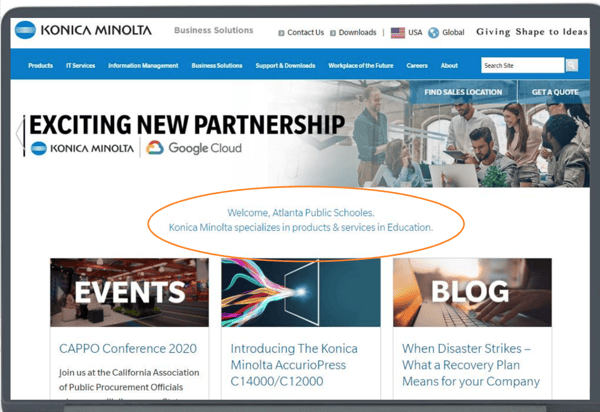
An example of a personalized content hub.
There are marketing software galore to fit the bill. Beyond kicking your CRM into overdrive, some of the top hosting and deployment platforms to consider creating personalized content hubs include Uberflip, ON24, Path Factory, Demandbase and more. G2 offers a helpful guide with ratings and reviews of the top digital content experience platforms out today here.
There’s also another suite of virtual hosting platforms that can meet your product demonstration needs including Adobe. These platforms can help you prospect and target clients, serve them and drive them to personalized streams of content and destinations and then measure and optimize the messaging all with the goal of moving them toward purchase.
Once you’ve squared away the right martech or hosting platform, you’re going to need to understand exactly who you’ll be marketing to, where they are in the buying journey and what content is going to be relevant to them. Then make it all sing with enough great content for all attendees. These digital experiences need to both educate and effectively showcase products. How? We suggest showcasing products in video or 3D formats in which audiences can interact.
Here’s a list of things to consider to ensure you’re hitting all the right notes with a virtual event that’s going to drive demand.
Did your industry trade show get cancelled and are you reeling from the hole left in your marketing calendar? Well the clients that planned on attending also missed out on learning about new products and services that can help their companies. Both sides are feeling the same way. A properly executed virtual event can remedy the situation and leave everyone walking away feeling happy and, more importantly, informed.
Exhibitors at shows typically have a few core goals in mind, most of which include getting in front of customers, industry thought leaders and press. While you do lose the ability to do live product demos, shake hands and see what your competitors are up to first-hand, a digital version of this can still check more boxes than you think.
Here’s a 3-step approach with tips included on pulling off a successful virtual trade show experience.

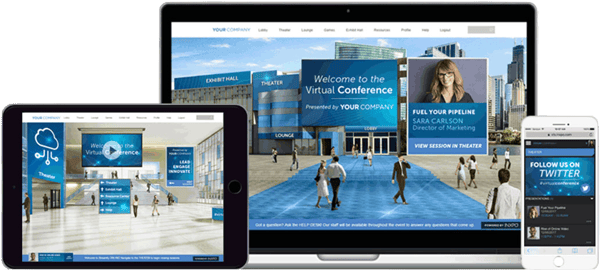
Pulling off a successful virtual trade event can solve some of your immediate sales and marketing goals. However, as B2B marketers look to create long-term momentum, they will need to begin telling authentic stories on why they matter.
As storytelling shifts even further into the digital space, brands need to embrace this as they look to drive awareness and begin engaging with target audiences at the top of the funnel.
We define brand storytelling as creating content experiences that grow awareness and form lasting connections. Experiences that not only let customers know about your products and services, but let them see what your company and brand are about. What you believe in and support. This is imperative to the modern buyer, especially in the current times.
This snapshot helps visualize the importance of understanding the customer through research and data and using that information to guide the storytelling content to be created and served:
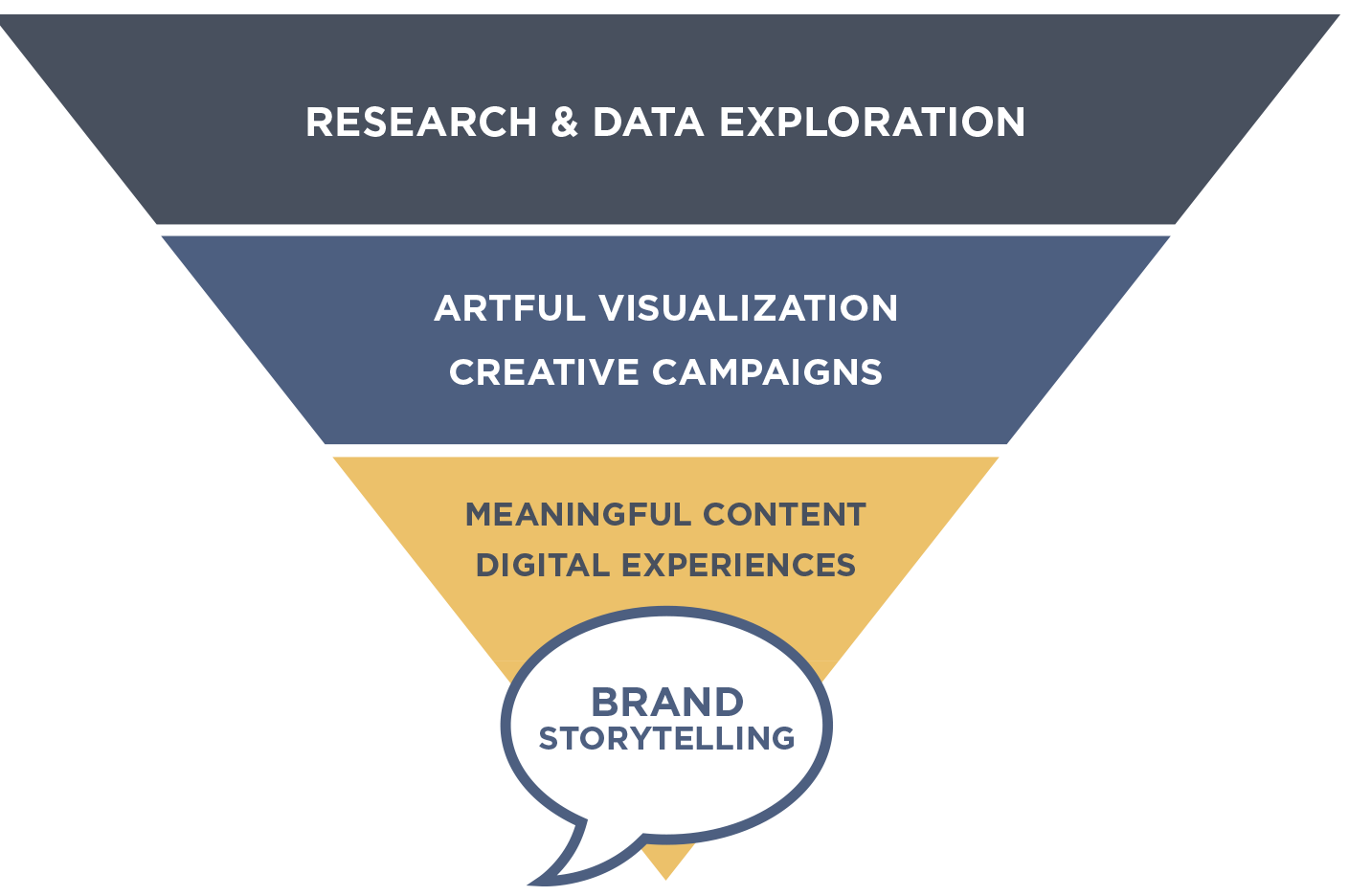
There are a multitude of owned and operated brand platforms in the digital space that can serve as great storytelling forums. The digital space has never been more heavily used than it is right now and the design and content delivery capabilities are simply amazing. More simply put, it’s where customers are and it’s where they look for great content.
Because the goal here is less about showcasing products for sale and more about a representation of what your brand stands for or something positive your products enable, it’s a very different approach to expressing this virtually.
There are typically longer form pieces of immersive written content and videos. Some of the core places brands can express themselves are on their website (i.e. the Our Story page), on YouTube brand channels or within a sponsored microsite. That’s not to say brands cannot also generate and distribute storytelling content in shorter formats across other channels as well.
Great storytelling content by B2B brands almost always includes the principles the company stands for, stance on an issue, innovations or products that are helping the world, and are meant for a specific audience.
Let’s run through some great examples:

This video does a wonderful job of covering company-wide innovations, details how their products are actually changing the world for the better and is addressing IoT decision makers.
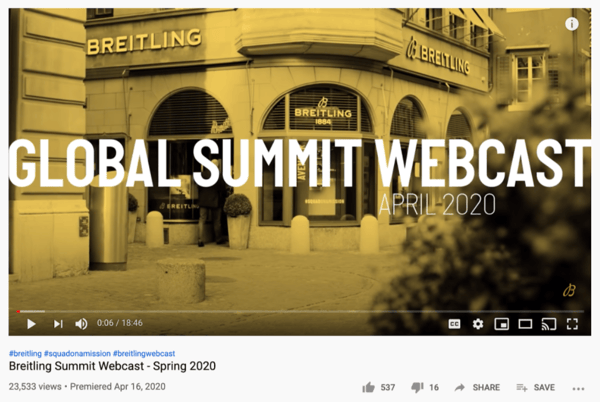
Breitling also used YouTube effectively creating a Global Summit Webcast to address their stance on the COVID-19 crisis, tell the stories behind their watch collections, and explore some of their limited edition timepieces.
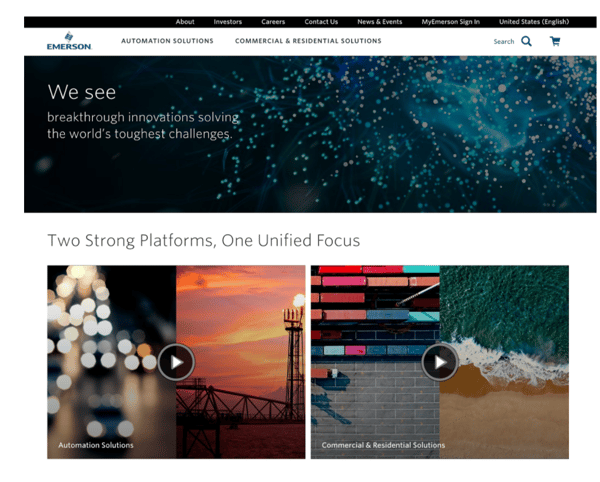
Next, Emerson, an automated technology solutions provider, hits all the right digital storytelling notes on their About Us and Featured Innovation Stories pages of their website by:
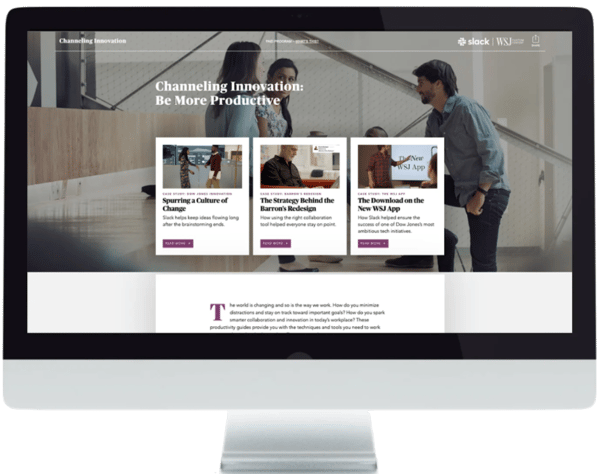
Brands also shouldn’t be strangers to creating or working with publishers to create custom landing pages to tell more specific stories. Here’s an example of The Wall Street Journal’s content studio The Trust working with Slack to create virtual solutions.
Here, they have used immersive videos, articles and infographics to tell the story of how Dow Jones employees are using Slack products and services to drive innovation.
Every brand has a story to tell, and online is the best place to tell them.
As brands grapple with trying to generate demand as we move through this crisis, the engine that’s going to power you through is a fully-informed and motivated sales team.
Until things loosen up, we will need to connect with our internal teams virtually for the foreseeable future. Even if teams in a regional office are able to get in the same room, we definitely aren’t hopping on a plane to attend the annual sales conference or company training seminar any time soon.
Fear not, a top-notch creative department feeding into some of today’s digital content platforms can pull off virtual sales enablement experiences that educate and inform. Customized sales hubs can provide a repository for marketing collateral and sales playbooks to supply your team with content that is productive, useful, and opportune during all aspects of the selling cycle.
Sales enablement tools ensure that any sales representative can find the proper content, deliver it to key prospects, and track their engagement accordingly. G2 offers a helpful guide with ratings and reviews of the top digital sales enablement platforms out today here.
Brands can also go the more conventional route and build their own sales hub or application on a platform of their choosing. A dedicated sales enablement content hub can serve your team with dynamic product demonstrations, vital details and downloadable content. These virtual experiences can also be solely dedicated to training your team in almost any capacity.
Now that we’ve reviewed specific solutions, you’ll notice a list of core virtual elements that can be used to service both internal teams and customers.
Here’s how we view the sales enablement ecosystem:
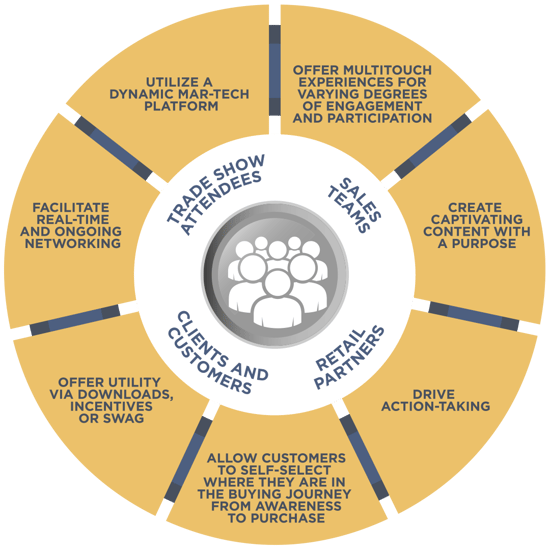

The Necessity of Virtual Solutions
Achieving Business Solutions Virtually
The Benefits of Virtual Experiences
COVID-19 may have forced our hand down this path, but as adoption of virtual and hybrid experiences continues to grow, more and more brands are beginning to see the benefits first-hand. By leaning even further into digital content software and virtual hosting platforms, nothing seems off the table as we reach, surround and move customers through online buying journeys with personalized content.
The benefits of virtual solutions include:

As we move through the current situation and brands lean more heavily into digital, don’t be surprised if virtual experiences go from a temporary solution, to the new expectation. They are proven to be an effective means of generating leads, driving demand, telling stories and equipping teams with everything they need to succeed.
The brands that figure this out sooner than their competitors will be the ones who lead the way by attracting more customers both virtually and literally.
In closing, we’ll leave you with a powerful line from Apple’s own Tim Cook during his virtual commencement address to Ohio State University:
"We can curse the loss of something that was never going to be, or we can see reasons to be grateful for the yank on the scruff of the neck, in having our eyes lifted up from the story we were writing for ourselves and turned instead to a remade world."

CSI is an independent, full-service creative agency that doesn’t believe in B2B or B2C. We believe in H2H: human-to-human. We're obsessed with understanding what makes people tick, what informs their buying decisions, and how to reach them in ways that drive real human connection and revenue for your brand.